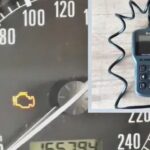Clearing an airbag light on your BMW can often be achieved with the right OBD II scanner, but it’s crucial to understand the compatibility limitations, especially for older models. If you’re encountering a persistent airbag warning light, diagnosing the issue yourself with an OBD II scanner can save time and money. However, not all scanners are created equal, and compatibility varies significantly depending on your BMW’s year of manufacture.
For BMW owners, particularly those with models from the early to mid-1990s, the effectiveness of standard OBD II airbag reset tools can be limited. Tools marketed as universal or even BMW-specific might not communicate correctly with the airbag system (SRS – Supplemental Restraint System) on these older vehicles.
Alt: An OBD II scanner tool being used to diagnose a car, highlighting automotive diagnostics.
One popular tool, the Peake SRS tool, is advertised to work with BMWs built between 1994 and 2002. This timeframe already excludes BMWs manufactured before 1994. Similarly, cheaper alternatives like the Chinese-made B800 SRS reset tool often face the same compatibility restrictions. Testing has shown these tools may not function on BMWs from the early 1990s or older, such as E32 models from the late 80s and early 90s. However, they may work on later E36 models from the mid to late 90s.
It’s essential to be aware of these limitations when choosing an OBD II scanner to address an airbag light issue. Misleading advertising is common, especially with tools like the B800. While marketing materials might list compatibility with a broad range of BMW models like E36, E46, E34, E38, E39, Z3, Z4, and X5, they often gloss over the crucial year range restriction, typically 1994-2003. Many of these listed BMW series were produced before 1994, rendering these tools ineffective for earlier models within those series.
Alt: A BMW 20-pin diagnostic port in the engine bay, illustrating older BMW diagnostic interfaces.
Another important factor for older BMWs is the diagnostic port location. Some models possess both a 20-pin round diagnostic port in the engine bay and a standard OBD II port near the steering wheel. For airbag system diagnostics on these vehicles, you should connect your SRS tool to the 20-pin port in the engine bay. The OBD II port in the cabin is often primarily for engine-related diagnostics, and may not provide access to the airbag system’s control unit. This applies to tools like the SIR3, BOA, and even the B800.
In conclusion, when dealing with an airbag light on your BMW, particularly if it’s a model manufactured before 1994, carefully verify the compatibility of your OBD II scanner. Don’t rely solely on general model compatibility lists. Focus on the specified year range and consider using the 20-pin diagnostic port if your BMW is equipped with one. Understanding these nuances will help you choose the correct OBD II scanner and effectively address your airbag light concern. Always consult your vehicle’s manual and reliable resources for the most accurate compatibility information before purchasing any diagnostic tools.

